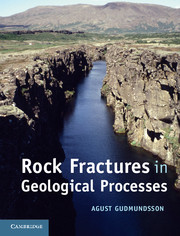Book contents
- Frontmatter
- Contents
- Preface
- Acknowledgements
- 1 Introduction
- 2 Stress
- 3 Displacement and strain
- 4 Relation between stress and strain
- 5 Loading of brittle rocks to failure
- 6 Stress concentration
- 7 Theories of brittle failure of rocks
- 8 Extension fractures and shear fractures
- 9 Displacements and driving stresses of fractures
- 10 Toughness and fracture mechanics
- 11 Field analysis of extension fractures
- 12 Field analysis of faults
- 13 Evolution of extension fractures
- 14 Evolution of faults
- 15 Fluid transport in rocks – the basics
- 16 Fluid transport in faults
- 17 Fluid transport in hydrofractures
- Appendix A Units, dimensions, and prefixes
- Appendix B The Greek alphabet
- Appendix C Some mathematical and physical constants
- Appendix D Elastic constants
- Appendix E Properties of some crustal materials
- Index
- References
4 - Relation between stress and strain
Published online by Cambridge University Press: 05 June 2012
- Frontmatter
- Contents
- Preface
- Acknowledgements
- 1 Introduction
- 2 Stress
- 3 Displacement and strain
- 4 Relation between stress and strain
- 5 Loading of brittle rocks to failure
- 6 Stress concentration
- 7 Theories of brittle failure of rocks
- 8 Extension fractures and shear fractures
- 9 Displacements and driving stresses of fractures
- 10 Toughness and fracture mechanics
- 11 Field analysis of extension fractures
- 12 Field analysis of faults
- 13 Evolution of extension fractures
- 14 Evolution of faults
- 15 Fluid transport in rocks – the basics
- 16 Fluid transport in faults
- 17 Fluid transport in hydrofractures
- Appendix A Units, dimensions, and prefixes
- Appendix B The Greek alphabet
- Appendix C Some mathematical and physical constants
- Appendix D Elastic constants
- Appendix E Properties of some crustal materials
- Index
- References
Summary
Aims
In this chapter we discuss the fundamental relationship between stress and strain, Hooke's law. This law describes approximately the stress–strain behaviour of many solid materials before failure, such as many metals, ceramics, and rocks. Elastic behaviour implies that the deformation is recoverable: a body that deforms elastically when loaded reverts to its original shape immediately when the load is removed. Most solid rocks behave as approximately elastic at low temperatures and pressures (that is, at shallow depths), up to strains of about 1%. Such strains are common in the crust before failure, hence the importance of Hooke's law for understanding processes leading to rock fractures. The main aims of this chapter are to:
Explain the one-dimensional Hooke's law, as well as its extension to three dimensions.
Discuss the elastic constants, the relations among them, and their physical meaning.
Show how to estimate the vertical and horizontal stress in the Earth's crust.
Provide information on the general state of stress in the Earth's crust.
Discuss and explain the use of some reference states of stress in the crust.
Explain the concept of elastic strain energy.
One-dimensional Hooke's law
Consider the comparatively isolated part of rock (a part of a basaltic dyke) in Fig. 4.1. This rock segment or ‘bar’ may serve as an illustration of the effects of the one-dimensional Hooke's law.
- Type
- Chapter
- Information
- Rock Fractures in Geological Processes , pp. 89 - 131Publisher: Cambridge University PressPrint publication year: 2011



